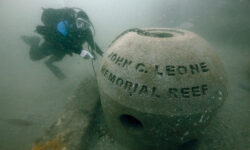8-12-12
The TISIRI team continued investigation efforts at the two offshore wreckage sites offshore St. Augustine. This post is in regards to wreck site 1, the area that has two Lycoming engines buried in the sea floor. Today one of the engines was lifted out of its buried state with the use of a heavy duty lift bag. This allowed TISIRI investigators to confirm the engine contained a 2 bladed propeller while revealing a stamped number near the propeller blades. Hopefully these features will help identify this aircraft. See pictures below and make note of the stamped number in the propeller picture. Please let us know if you can help us further id this aircraft with this new information.




















Please let us know if there is a way to use the number found on the prop to help identify the engine and aircraft.
Perhaps Lycoming will be able to help with the propeller number.
The number on the prop hub is the prop serial number. It’s a Hartzell prop, made in Piqua, Ohio. The company MAY be able to tell you what model number prop it is, if they still have a record of the serial number. If you know the model, you can determine what aircraft models that particular prop was certified to be installed on. Even if Hartzell can tell you to whom they sold the prop, that is unlikely to help much in determining the aircraft on the ocean floor. An aircraft manufacturer would know what serial number props and engines were on a particular plane when it left the factory. But, props (and engines) get changed all the time for various reasons and that style 2-bladed prop hasn’t been install on new aircraft in 30 years or more. There is no “master record ” at the FAA or anywhere else that contains info about serial numbers of props or engines and what aircraft they are currently installed on. When any component is changed in the field the aircraft and/or engine log book is updated and the job is done.
Usually aircraft log books are not carried on board the aircraft but are kept in a safe place. If the log books from the lost aircraft are still available then the model and serial numbers for the engines and propellers should be listed in the Propeller and Engine Log Books. Also on the Lycoming engine there should be a stainless data plate riveted on the side of the oil sump (oil Pan), with the model and serial numbers of the engine stamped as well. If I can of further assistance feel free to contact me at your earliest convenience.
Beechcraft twin bonaza’s were fitted with the lycoming O-480’s. The O480’s photo on wikipedia resembles the configuration of the engine air bagged. Looking at Wikipedia the photo of the Beech model 50 twin bonanza also has the twin stripes on the prop blades. I realize this is really thin info, but maybe it can help id the site.
Based on the information we have gathered this far it is thought the aircraft engine lifted was probably from a Piper Aztec. This is what Hartzell propeller has told us after research the prop #’s found.
I have been working on Aztecs for quite some time now. I agree completely that this is an Aztec engine. Keep looking for the second one (assuming this one didn’t fall off in flight). On second thought… That is a very strong possibility. The missing chunk of the propeller tip may very well have caused such a massive vibration that the engine actually did separate in flight. That being said, there is no telling where the remainder of the aircraft could be. I have been scouring NTSB reports all day trying to find any type of incident that matches this wreck with no luck. This leads me to believe that you may have found the remains of a drug smuggling plane. The Aztec is a very popular aircraft for that purpose.
Ok… I am on a trail here… I have to take back the Aztec part of my statement. I am going to see if the Aztec propeller is also used on a PA-32-260 (Cherokee 260). My boss noticed the engine mount structure is similar to that used on the Cherokee. Also, I have never seen an Aztec engine with a prop extension and no fuel injector lines clamped to the push rod housings… They are stainless steel and should still be there, but there are none. Hmmm… back to the NTSB site.
Nathan,
Thanks for your continued input. We have located the second engine. See pictures here http://www.tisiri.org/plane-crash-investigation-offshore-downed-aircraft/
We have determined the prop shown above is a Hartzell propeller. We have contacted the company and they were able to tell us the prop was made in 1968 and sold to Piper. Hartzell stated the prop would have been for a Piper Aztec.
One other thing we have not mentioned yet is that we were able to recover a small piece of fuselage. It was found near the engine. There are traces of blue paint on the pieces recovered.
Good to hear that. This is incredibly interesting to me as an aircraft mechanic, aspiring aerospace engineer and avid scuba diver. I think your company’s work is amazing.
[…] Kistel, a marine conservationist and the executive director of an artificial reef building company in Jacksonville, led a dive last weekend to search for […]
I see a lot of interesting content on your page.
You have to spend a lot of time writing, i know how to save you a lot of work, there is a tool that creates unique, google friendly posts in couple of minutes,
just type in google – laranita’s free content source